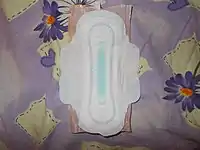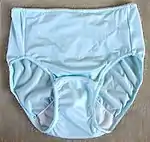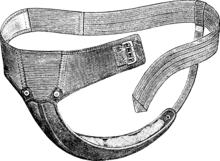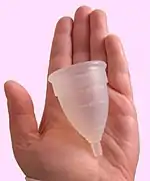Feminine hygiene
Feminine hygiene products are personal care products used during menstruation, vaginal discharge, and other bodily functions related to the vulva and vagina. Products that are used during menstruation may also be called menstrual hygiene products, including menstrual pads, tampons, pantyliners, menstrual cups, menstrual sponges and period panties. Feminine hygiene products also include products meant to cleanse the vulva or vagina, such as douches, feminine wipes, and soap.

Feminine hygiene products are either disposable or reusable. Sanitary napkins, tampons, and pantyliners are disposable feminine hygiene products. Menstrual cups, cloth menstrual pads, period panties, and sponges are reusable feminine hygiene products.[1]
Types
Menstrual hygiene products




Disposable:
- Menstrual pad: Made of absorbent material that is worn on the inside of underwear to absorb a heavier menstrual flow. They are made of cellulose and are available in many different absorbencies and lengths. They may have wings and/or an adhesive backing to hold the pad in place.[2][3][4]
- Pantyliner: Similar to a menstrual pad, they are smaller, thinner and used for lighter periods, intermittent bleeding and vaginal discharge, or as a supplement to a tampon.[2][3]
- Tampon: Inserted inside the vagina to absorb menstrual blood, can also be used while swimming. Available in different levels of absorbency.[2][3][4]
Reusable:
- Menstrual cup: Made of silicone, natural rubber, or plastic; is inserted inside the vagina to catch blood and/or uterine lining.[5] Most are reusable: they are emptied when full and can be washed or boiled.
- Cloth menstrual pad: Worn inside underwear; can be made of materials such as cotton, flannel or terry cloth.[5]
- Period underwear (AKA period panties): Can refer to either underwear that keeps pads in place, or absorbent underwear that can take the place of tampons and pads.[5]
- Menstrual sponge: Inserted like a tampon or cup and worn inside the body.[6]
- Towel: large reusable piece of cloth, most often used at night (if nothing else is available), placed between legs to absorb menstrual flow.
Areas of concern:
- Toxic shock syndrome: The use of tampons or menstrual cups can rarely cause a dangerous condition called toxic shock syndrome, which is a rare, life-threatening complication of certain types of bacterial infections.[7] To help prevent toxic shock syndrome, the lowest needed absorbency of tampon should be used and tampons should be changed at least every four to eight hours. Minipads should be used for light menstrual flow.
- Women may have difficulty with staining of their garments or sheets during menstruation. This can be mitigated by wearing dark or black underwear or pants and sleeping on top of a towel at night.
Cleansing products
- Douches: A fluid used to flush out the inside of the vagina.[4]
- Feminine wipes: A moist, sometimes scented cloth used to wipe the vulva.[8]
Feminine hygiene products that are meant to cleanse may lead to allergic reaction and irritation, as the vagina naturally flushes out bacteria.[9] Many health professionals advise against douching because it can change the balance of vaginal flora and acidity.[10]
Risks
The different products may carry some health risks, some of which might be proven, others speculative.[11][12][13]
- Toxic shock syndrome: A rare illness that may occur when tampons are worn for long periods of time, although not directly linked to tampon use but caused by poison linked to bacteria of the Streptococcus pyogenes or Staphylococcus aureus type.[4][3]
- Irritation: Can be caused by fragrances, neomycin (adhesive on pads), tea tree oil, benzocaine. Inflammation can also be a risk associated with some products.[4]
- Yeast infection: A fungus.[3]
- Bacterial vaginosis: Overgrowth of naturally occurring bacteria in the vagina that leads to a type of vaginal inflammation. The imbalance of bacteria from its natural state has been connected to bacterial vaginosis [14][15][16]
- Exposure to chemicals: some period underwear companies (like Thinx, Ruby Love, and Knix) are facing class action lawsuits for products containing harmful toxins like per- and polyfluoroalkyl substances (PFAS)[17] which may be linked to adverse health outcomes like cancer.[18]
Society and culture
According to the World Health Organization, as of 2018 there are about 1.9 billion women who are of reproductive age.[19] In low-income countries, women's choices of menstrual hygiene materials are often limited by the costs, availability and social norms. Not only are women's choices limited but, according to the WHO and Unicef, 780 million people do not have access to improved water sources and about 2.5 billion people lack access to improved sanitation. The lack of proper hygiene leads to a harder time for women to manage feminine hygiene.[20][21][19][22]
Costs and tax

Tampon tax is a shorthand for sales tax charged on tampons, pads, and menstrual cups. The cost of these commercial products for menstrual management is considered to be unacceptably high for many low-income women. At least half a million women across the world do not have enough money to adequately afford these products. This can result in missing school or even dropping out. In some jurisdictions similar necessities like medical devices and toilet paper are not taxed. Several initiatives worldwide advocate to eliminate the tax all together. In some countries, such petitions have already been successful (for example parts of the UK and the United States).[23][24][25]
Access to products in prisons
The Federal Bureau of Prisons in the United States announced that women in its facilities would be guaranteed free menstrual pads and tampons. In section 411 of the First Step Act which was passed on May 22, 2018 states, "The Director of the Bureau of Prisons shall make the healthcare products described in subsection (c) available to prisoners for free, in a quantity that is appropriate to the healthcare needs of each prisoner".[26]
Other social views
Some girls and women may view tampons and menstrual cups as affecting their virginity even though they have not engaged in sexual intercourse.[4]
For those with autism, using pads before menstruation begins may help reduce sensory issues associated with menstrual hygiene products. Prior education and practice may help familiarize an individual with body changes and the process of using products associated with menstruation.[27]
Menstruation may occur despite paralyzation; product use depends on the individual's personal preference.[28]
History

_151_Periodenbinde.png.webp)
In ancient Egypt, the Roman Empire and Indonesia, various natural materials – wool, grass, papyrus – were used as tampons. In ancient Japan, the tampon was made of paper and held in place by a special binder called kama, and was changed up to 12 times a day.[29]
In 18th-century Sweden, women in common society were not known to use feminine hygiene products and visible period stains on clothing did not attract much attention. A common expression for menstruation during this period was to "wear the clothes" or "wear the särk", a chemise-like undergarment.[30]
It is likely that pieces of cloth or special rags were used to collect the menstrual fluid. However, there are few records of menstrual pads from the pre-industrial era.[31] As artifacts, the various types of menstrual pads have not been preserved or survived in any particular sense, as the cloths used were discarded when they became worn out or the need for them ceased with menopause. However, as technology evolved, commercial hygiene products were introduced in the form of the menstrual pad, also known as the sanitary napkin. In Sweden, this happened at the end of the 19th century and has been linked to an increased focus on cleanliness, personal hygiene and health that occurred in the early part of the 20th century in the wake of urbanization.[32] By the end of the 19th century, the first commercial sanitary napkin had also been introduced on the American market by Johnson & Johnson. It was a variant of the menstrual pad made of flannel.[33]
Advertisements and product information for sanitary pads are the primary source of knowledge about the history of sanitary pads.[34]

Early 20th-century commercial products
Sanitary napkins could be made of woven cotton, knitted or crocheted and filled with rags.[35] They could be homemade for personal use or mass-produced and sold, such as in towns that had a textile industry.[36]
The menstrual receptacle was the very earliest hygiene product to be launched as menstrual protection in Sweden, as early as 1879. It was made of rubber, like many of the hygiene articles of the time, and resembled a bowl-shaped casing that would sit on the outside of the abdomen. The menstrual receptacle is not considered to have gained much popularity.[37]
The first half of the 20th century also saw the development of early intravaginal menstrual products similar to the menstrual cup, with an early patent dating from 1903.[38]
Menstrual belts were another form that menstrual protection took and began to appear in the late 19th century. They were made so that the pad itself was contained in a special holder that was fastened around the waist with a belt. The pads in these designs are referred to as "suction pads" in Swedish patent documents, such as the "Suction pad for menstruation" patent from 1889.[39] The price for a menstrual belt could be between 2.75 – 3.50 SEK and pads had to be purchased for about 4–5 SEK each, depending on the size of the pack. From the price information available, menstrual protection was likely a costly purchase that was not available to everyone.[32]
The sanitary belt can be seen as a modern version of the menstrual belt, but more like a girdle. The function of the belt is to hold the pad in place while giving the user greater freedom of motion.[40] In Sweden, the product was introduced in the 1940s and was in use until the 1960s.[41] In the 1970s, the adhesive strip on the underside of the pad was introduced, allowing it to be attached to the underwear and held in place without the use of a girdle, safety pin or belt.[42]
See also
References
Notes
- Nicole, Wendee (March 2014). "A Question for Women's Health: Chemicals in Feminine Hygiene Products and Personal Lubricants". Environmental Health Perspectives. 122 (3): A70–A75. doi:10.1289/ehp.122-A70. PMC 3948026. PMID 24583634.
- Schaefer, Valorie Lee, et al. The Care & Keeping of You 1: The Body Book For Younger Girls. American Girl, 2018.
- Natterson, Dr. Cara, and Josée Masse. The Care and Keeping of You 2 The Body Book for Older Girls. American Girl Publishing, 2012.
- Stewart, Elizabeth Gunther. (2002). The V book : a doctor's guide to complete vulvovaginal health. Bantam Books. ISBN 9780307492449. OCLC 773813783.
- "How Do I Use Tampons, Pads, Period Underwear & Menstrual Cups? | Facts & Info". www.plannedparenthood.org. Archived from the original on 2019-10-29. Retrieved 2019-11-18.
- Kim, Naeun (2015-11-10). "Soaking It Up With Menstrual Sea Sponges". Vice. Archived from the original on 2019-11-18. Retrieved 2019-11-18.
- "Toxic Shock Syndrome | Facts & Info". www.mayoclinic.org. Archived from the original on 2022-09-28. Retrieved 2022-09-28.
- Benton, Emilia (2019-10-16). "These Are The Feminine Wipes Gynos Actually Recommend". Women's Health. Archived from the original on 2019-11-18. Retrieved 2019-11-18.
- "Feeling Fresh". kidshealth.org. Archived from the original on 2018-11-08. Retrieved 2018-11-07.
- "Douching | Womenshealth.gov". womenshealth.gov. 2017-02-21. Archived from the original on 2018-11-07. Retrieved 2018-11-07.
- "Are panty liners beneficial or harmful? I alternative to panty liners". UTI prevention I Vaginal care I Ezspur. Archived from the original on 2018-11-18. Retrieved 2018-11-18.
- "Cloth Pad Pros & Cons". Reusable Menstrual Products. 2016-11-23. Archived from the original on 2018-11-18. Retrieved 2018-11-18.
- "Should We Really Be Using Feminine Care Wipes for Down There?". InStyle.com. Archived from the original on 2018-11-18. Retrieved 2018-11-18.
- Klebanoff MA, Nansel TR, Brotman RM, Zhang J, Yu KF, Schwebke JR, Andrews WW (February 2010). "Personal Hygienic Behaviors and Bacterial Vaginosis". Sexually Transmitted Diseases. 37 (2): 94–99. doi:10.1097/OLQ.0b013e3181bc063c. PMC 2811217. PMID 19823112.
- "Douching". Pffice on Women's Health. Archived from the original on 2020-12-26. Retrieved 2020-12-23.
- Pallett, Abitha (December 14, 2020). "Keeping the Vagina and Vulva Clean". YourPeriodCalled. Archived from the original on 2021-03-01. Retrieved 2020-12-14.
- "Lawsuit Investigation Looks at PFAS Levels in Menstrual Underwear". www.classaction.org. 2020-08-26. Archived from the original on 2023-01-17. Retrieved 2023-01-25.
- US EPA, OA (2021-10-14). "Our Current Understanding of the Human Health and Environmental Risks of PFAS". www.epa.gov. Archived from the original on 2023-01-24. Retrieved 2023-01-25.
- "Tackling the taboo of menstrual hygiene in the European Region". www.euro.who.int. Archived from the original on 2021-09-22. Retrieved 2021-03-03.
- UNESCO (2014). Puberty Education & Menstrual Hygiene Management - Good Policy and Practice in health Education - Booklet 9 Archived 2015-04-02 at the Wayback Machine. United Nations Educational, Scientific and Cultural Organization, Paris, France, p. 32
- Kaur, Rajanbir; Kaur, Kanwaljit; Kaur, Rajinder (2018). "Menstrual Hygiene, Management, and Waste Disposal: Practices and Challenges Faced by Girls/Women of Developing Countries". Journal of Environmental and Public Health. 2018: 1730964. doi:10.1155/2018/1730964. ISSN 1687-9805. PMC 5838436. PMID 29675047.
- "Global WASH Fast Facts | Global Water, Sanitation and Hygiene | Healthy Water | CDC". www.cdc.gov. 2018-11-09. Archived from the original on 2021-03-02. Retrieved 2021-03-03.
- "Could this be the first country to end 'period poverty'?". www.msn.com. Archived from the original on 19 April 2018. Retrieved 2 May 2018.
- Nosheena Mobarik (3 October 2018). "Mobarik: UK one step closer to ending the tampon tax". Conservatives in the European Parliament. Archived from the original on 14 April 2019. Retrieved 15 October 2018.
- "Women get their periods every month — and it's incredibly expensive". USA TODAY. Archived from the original on 2021-01-25. Retrieved 2018-10-15.
- "Text - H.R.5682 - 115th Congress (2017-2018): FIRST STEP Act". 2018-05-23. Archived from the original on 2018-12-22. Retrieved 2018-11-13.
- Lyons, Tony. (2015-04-14). 101 Tips for the Parents of Girls with Autism : the Most Crucial Things You Need to Know About Diagnosis, Doctors, Schools, Taxes, Vaccinations, Babysitters, Treatment, Food, Self-Care, and More. ISBN 9781629148427. OCLC 1054370720.
- Farrell, Kate, et al. Period: Twelve Voices Tell the Bloody Truth. Feiwel and Friends, an Imprint of Macmillan Publishing Group, LLC, 2018.
- Delaney, Janice; Lupton, Mary Jane; Toth, Emily (1988). The Curse: A Cultural History of Menstruation. University of Illinois Press. p. 138. ISBN 978-0-252-01452-9.
- Malmberg 1991, pp. 60–61.
- Malmberg 1991, p. 66.
- Malmberg 1991, p. 158.
- Wysocki, Susan (1997-11-01). "New Options in Menstrual Protection on ADVANCE for Nurse Practitioners". Archived from the original on 2009-05-24. Retrieved 2017-06-11.
- Malmberg 1991, p. 114.
- "Dambinda" (in Swedish). Digitalt Museum. Retrieved 2015-02-01.
- Malmberg 1991, p. 148.
- Malmberg 1991, p. 138–139.
- "Catamenial sack". Google Patents. 1903. Archived from the original on 2016-06-17. Retrieved 2023-03-09.
- "Sugdyna för menstruationer" (PDF). Swedish Intellectual Property Office (in Swedish). 1889. Archived (PDF) from the original on 2023-03-21. Retrieved 2023-03-09.
- "Sanitetsgördel". Digitalt Museum (in Swedish). Archived from the original on 2016-01-27. Retrieved 2015-12-12.
- "Sanitetsgördel". Digitalt Museum (in Swedish). Archived from the original on 2016-01-27. Retrieved 2016-01-08.
- Bobel, Chris (2010). New Blood - Third-Wave Feminism and the Politics of Menstruation. Rutgers University Press. p. 46. ISBN 9780813547541.
- Stein, Elissa (2009). Flow : the cultural story of menstruation. St. Martin's Griffin. ISBN 9780312379964. OCLC 946560416.
- ONEILL, THERESE. (2018). UNMENTIONABLE : the victorian lady's guide to sex, marriage, and manners. BACK BAY Books LITTLE BRN. ISBN 978-0316357906. OCLC 1003312707.
Sources
- Malmberg, Denise (1991). Skammens röda blomma – menstruationen och den menstruerande kvinnan i svensk tradition [The red flower of shame?: menstruation and the menstruating woman in Swedish tradition] (in Swedish). Uppsala University. ISBN 9789150608830.
External links
 Media related to Feminine hygiene at Wikimedia Commons
Media related to Feminine hygiene at Wikimedia Commons
